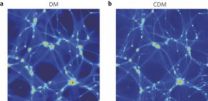(Press-News.org) Although food allergies are common, sufferers often don't know exactly what in foods cause their allergic reactions. This knowledge could help develop customized therapies, like training the body's immune system to respond to certain proteins found in foods. However, determining which protein in a food causes an allergic response to a patient requires time-consuming tests that often ignore rare or unexpected allergens. Publishing in Analytical Chemistry, EPFL scientists have developed a highly-sensitive method that can quickly and accurately identify the culprit proteins even at very low concentrations. The method has been successfully tested in the context of cow milk allergy.
Food allergies are becoming widespread in the Western world today, affecting around 6-8% of children and about 3% of adults. These types of allergies occur when the body's immune system mistakes a harmless food protein for a threat and attacks it as it would normally do with a bacterium or a virus. This causes symptoms like swelling, rashes, pain, and even life-threatening anaphylactic shocks.
Cow milk allergy is common among children, preventing them from breast feeding and drinking milk, although some outgrow the allergy by six years of age. Allergies, including food allergies, are caused when our immune system produces antibodies to destroy "enemy" molecules, like those from bacteria and viruses. In the case of milk allergies, the antibodies are called "IgE". Medical doctors can diagnose milk allergies by simply detecting an overproduction of IgE, but that does not tell them which one of the numerous proteins in milk – and other foods – is causing the allergic response.
The team of Hubert Girault at EPFL has developed a highly-sensitive method that uses a patient's IgE to determine specifically which protein induces allergic responses in them. The method uses a well-established technique called immunoaffinity capillary electrophoresis (IACE). First, IgE antibodies from the patient's blood are isolated by interaction with magnetic beads that are coated with a different type of antibody. The "bead" antibodies recognize and bind the patient's IgE antibodies. This takes place inside a long and narrow glass tube, only 50 micrometers in diameter, called a "capillary". The bound antibodies are then flushed out of the capillary and powerfully attached to the magnetic beads through a process called 'crosslinking', which keeps them from detaching. The beads with the patient's IgE are then placed again inside the capillary.
The test begins when milk is injected through the capillary. As the milk's proteins pass over the patient's IgE antibodies, the ones that cause allergies are caught by them, while the others exit on the other side. The beads are then washed with a strong chemical that causes the allergy-inducing protein to dissociate from the patient's IgE antibodies. The isolated, "culprit" protein is then identified using mass spectrometry, which is a technique that analyzes compounds according to their mass and electrical charge.
The method offers a personalized way to identify the exact proteins that can cause food allergies to a patient, which can help develop an effective treatment. It is also quicker, as it does not require the detection and quantification of a patient's specific IgE antibodies or the laborious and resource-intensive diagnostic methods used currently. Finally, it provides higher accuracy than conventional allergy-testing methods, as it can detect tiny amounts of allergic proteins, even if they are unexpected and rare. This also means that the method can be extended beyond milk to other foods like nuts and wheat products.
INFORMATION:
The allergic blood serum used in this work was purchased from Bioreclamation LLC (New York). Non-allergic blood serum used as a control was kindly donated by the Regional Blood Transfusion Service of Vaud (Switzerland).
Reference
Gasilova N, Girault HH. Component-Resolved Diagnostic of Cow's Milk Allergy by Immunoaffinity Capillary Electrophoresis–Matrix Assisted Laser Desorption/Ionization Mass Spectrometry. Analytical Chemistry 10 June 2014. DOI: 10.1021/ac500525n
Food allergies: A new, simple method to track down allergens
2014-07-02
ELSE PRESS RELEASES FROM THIS DATE:
Socioeconomic status associated with peripheral artery disease risk
2014-07-02
Previous research has established a link between lower socioeconomic status and an increased risk of cardiovascular disease. In a new study led by Brigham and Women's Hospital (BWH), researchers have found that there are also higher rates of peripheral artery disease (PAD) in individuals with low income and lower attained education levels in the United States.
These findings are published online ahead of print in Circulation: Cardiovascular Quality and Outcomes.
"Our finding highlights the need to focus on education and advocacy efforts for these at-risk populations," ...
Reinterpreting dark matter
2014-07-02
This news release is available in Spanish.
In cosmology, cold dark matter is a form of matter the particles of which move slowly in comparison with light, and interact weakly with electromagnetic radiation. It is estimated that only a minute fraction of the matter in the Universe is baryonic matter, which forms stars, planets and living organisms. The rest, comprising over 80%, is dark matter and energy.
The theory of cold dark matter helps to explain how the universe evolved from its initial state to the current distribution of galaxies and clusters, the structure ...
Weekend emergency surgeries deadlier for children
2014-07-02
Children who undergo simple emergency surgeries, such as hernia repairs or appendix removals, on weekends are more likely to suffer complications and even die than children getting the same kind of treatment during the week, according to results of a Johns Hopkins Children's Center study.
The Johns Hopkins team says that although the number of deaths was small, the marked difference in death and risk of other complications points to a worrisome "weekend effect" observed across hospitals nationwide that calls for an in-depth examination of possible after-hours safety lapses ...
One in six adolescents in the ER has experienced dating violence
2014-07-02
WASHINGTON — Of adolescents visiting the emergency department for any reason, one in five girls and one in eight boys reported dating violence in the past year. According to a study published online Monday in Annals of Emergency Medicine, dating violence among adolescents was also strongly associated with alcohol, illicit drug use and depression ("Dating Violence Among Male and Female Youth Seeking Emergency Department Care") http://tinyurl.com/oakk4aq.
"An enormous number of youth and adolescents have already experienced violence in their dating lives," said lead ...
A stellar womb shaped and destroyed by its ungrateful offspring
2014-07-02
This image was taken as part of the ESO Cosmic Gems programme [1] using the Wide Field Imager on the MPG/ESO 2.2-metre telescope at the La Silla Observatory in Chile. It shows Gum 15, located in the constellation of Vela (The Sails), some 3000 light-years from Earth [2]. This glowing cloud is a striking example of an HII region [3]. Such clouds form some of the most spectacular astronomical objects we can see; for example the Eagle Nebula (which includes the feature nicknamed "The Pillars of Creation"), the great Orion Nebula , and this less famous example, Gum 15.
Hydrogen ...
'Deep learning' makes search for exotic particles easier
2014-07-02
Irvine, Calif. — Fully automated "deep learning" by computers greatly improves the odds of discovering particles such as the Higgs boson, beating even veteran physicists' abilities, according to findings by UC Irvine researchers published today in the journal Nature Communications.
"We are thrilled with the publication of our work," said co-author Pierre Baldi, Chancellor's Professor of computer science, "and even more so with the hope that deep learning may help solve fundamental open questions about the nature of matter, gravity and the origin of the universe."
Baldi, ...
Superconducting-silicon qubits
2014-07-02
Theorists propose a way to make superconducting quantum devices such as Josephson junctions and qubits, atom-by-atom, inside a silicon crystal. Such systems could combine the most promising aspects of silicon spin qubits with the flexibility of superconducting circuits. The researcher's results have now been published in Nature Communications (1).
High quality silicon is one of the historical foundations of modern computing. But it is also promising for quantum information technology. In particular, electron and nuclear spins in pure silicon crystals have been measured ...
From despair to repair: Dramatic decline of Caribbean corals can be reversed
2014-07-02
Gland, Switzerland – With only about one-sixth of the original coral cover left, most Caribbean coral reefs may disappear in the next 20 years, primarily due to the loss of grazers in the region, according to the latest report by the Global Coral Reef Monitoring Network (GCRMN), the International Union for Conservation of Nature (IUCN) and the United Nations Environment Programme (UNEP).
The report, Status and Trends of Caribbean Coral Reefs: 1970-2012, is the most detailed and comprehensive study of its kind published to date – the result of the work of 90 experts over ...
License plate readers are important police tool, but hurdles remain, study finds
2014-07-02
Systems that automatically read automobile license plates have the potential to save police investigative time and increase safety, but law enforcement officials must address issues related to staffing, compatibility and privacy before the technology can reach its full potential, according to a new RAND Corporation report.
As part of efforts to promote innovation in law enforcement, many of the first generation license plate reader systems were purchased with federal and state grants. As these funding streams can be inconsistent, law enforcement agencies are – or will ...
A 'magic moment' for unwed parents
2014-07-02
DURHAM, N.C. -- If unwed parents are going to get married, the best window of opportunity for that union seems to be before their child turns 3, says a new study from Duke University.
But patterns vary greatly by race, with more African-American mothers marrying much later than mothers of other races or ethnicities.
Federal policies have often presumed that unmarried parents will be most receptive to marriage right after a baby's birth, a period that has been dubbed the "magic moment." The new study is the first to test that assumption, said author Christina Gibson-Davis. ...



